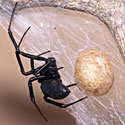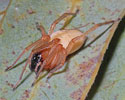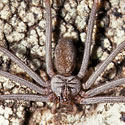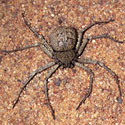|
Spider Bites
Back to spider home
Introduction
The most frequently asked question related to spiders is
“is it poisonous?” The answer is that I do not know. One has to eat a spider and
if this results in one becoming sick or dying then the spider can be said to be
poisonous. The question should be “is it harmful or dangerous and of medical
importance?” Ménez writes that in 1781 Italian researcher Felix Fontana proved
that viper venom was harmless when swallowed but highly toxic when injected into
rabbits. Venom is the term used for toxic substances, composed of complex
proteins and enzymes, that have to be injected into animal tissue with an
injecting apparatus such as the sting of a scorpion or insect or the fangs of a
spider or snake.
It must be noted that deaths from spider envenomation are
rare and appear to be grossly exaggerated in all parts of the world. Deaths
normally are the result of complications, such as infections or a weakened
condition, and improper medical care.
Death or severe skin injuries are often reported in
newspapers or via the internet but these are normally hoax claims which are
circulated in ignorance. It has been estimated that of all the cytotoxic spider
bites reported by doctors, 70-80% are proven not to be spider related at all.
Further it must be noted that some people show reactions to relatively harmless
spider bites. Despite all the anxiety over being bitten by spiders, there have
been no known deaths from spiders bites in South Africa in the past 60 years.
To confirm a positive spider bite the spider has to be
caught in the act of biting or the resulting signs and symptoms have to follow a
specific course. A spider found randomly in the vicinity does not imply that it
is the culprit and it is important that an expert identifies the collected
specimen. Medical practitioners are not spider or spider bite experts and
often make an incorrect diagnosis. Treatment must always be directed at
treating the signs and symptoms that present and not the bite. Scorpions and
venomous snakes can administer a full sting or bite without injecting venom and
spiders can similarly bite without injecting venom. This is referred to as a dry
bite.
Not everyone will be affected in the same way by a spider bite. The severity
depends on the amount of venom injected, the health of the patient,
allergies, age (small children and the elderly are more adversely affected)
and the site of the bite. Some patients display symptoms of stress/trauma,
incorrectly called “shock” that can be misleading, leading one to fear the worst
of a harmless spider bite. Others will present with mild reactions.
Types of bites
Currently there are over 42751 described species of spiders in 110
families. Of these, about 2000 species and 70 families are known from South
Africa. All these families, bar the Uloboridae, possess venom glands and are
thus venomous but only three families are known to contain spiders that are of
medical importance and can therefore be said to be harmful to humans. There are
probably other spiders that can inflict serious bites but only those that come
into regular contact with humans are recorded as medically important.
The medically important families are:
- Theridiidae with 6
Latrodectus species in
southern Africa that have
neurotoxic venom.
- Miturgidae with
Cheiracanthium furculatum the only species implicated. All
species of Cheiracanthium must be considered as medically important.
- Sicariidae with
Loxosceles and
Sicarius. The latter occurring in areas of low
habitation and not positively implicated in documented cases.
|
Neurotoxic bites Neurotoxic venom affects
the neuromuscular junctions and has a general effect on the physiology of
the person bitten with symptoms including sharp burning pain at the bite
site, tender lymph nodes, severe muscle pain and cramps, chest tightness and
pain, tremors, excessive salivation and watery eyes, facial swelling, droopy
eyelids, anxiety, slight fever, slurred speech, nausea, vomiting and
headaches,excessive sweating, heart palpitations, pins and needles, and
breathing difficulties |
|
|
|
Button spider (Latrodectus) bites
Button spiders fall in the genus Latrodectus
(family Theridiidae) with six
species occurring in southern Africa. Of these,
Latrodectus indistinctus
(Black button spider) is the most important species medically. |
 |
|
Cytotoxic bites Cytotoxic venom causes
death of tissue at the site of the bite, resulting often in a large
ulcerating wound. |
|
|
|
Sac spider (Cheiracanthium) bites
The Long-legged sac spider,
Cheiracanthium furculatum
is often found in houses and in South Africa has been implicated in 70-75%
of spider bites that cause death of tissue at the site of the bite (necrotic
envenomations). |
 |
|
|
Violin spider (Loxosceles) bites
The cytotoxic effects are more extreme with violin spider
bites than with those of sac spiders. Bites normally occur at night and are
not felt as the tiny fangs only just penetrate the skin. A swelling develops
eventually resulting in a blister after 2-3 days. This collapses at 10 days
leaving a necrotic crater-like lesion 20-100mm in diameter. |
 |
|
|
Sicarius bites
These spiders live in arid regions and hence are rarely
associated with people. There are very few documented bites of humans by
these spiders. Experimental animals bitten by Sicarius presented with massive tissue destruction and
death (77%), a postmortem revealing destruction of the internal organs. These
spiders must be regarded as potentially lethal. |
 |
Minor Spider Bites
In 1939 Finlayson reported that the bite of
Harpactirella lightfooti Purcell,
1902, Lightfoot’s lesser baboon spider, from Jutton Island and the Paarl area,
to be of medical importance as test animals died. There appears to be no proof
that these lesser baboon spiders are any more venomous than other local species
of Harpactira (common baboon spider). Harpactirella are usually rather
aggressive spiders but probably present with a similar reaction as some species
of Harpactira namely, extreme local pain lasting from 1-20 hours. No further
signs or symptoms were noticed.
Early experiments were done by Steyn (1959), where
Palystes superciliosus
(= Palystes natalius) were forced to bite guinea pigs on the nose with the
subsequent death of the animals. Newlands and Martindale (1981) repeated the
experiment and it was found that the guinea pigs died of stress/trauma.
Anaesthetised guinea pigs did not die. There have been cases where humans bitten
have presented with psychosomatic symptoms that are no more than an irritating
reaction to Palystes bites.
There have been reports of bites by species of Pararabeus and
Araneus (Araneidae), which resulted in a mild envenomation similar to button spider bites.
Bites by spiders of the families Salticidae (jumping spiders) and Lycosidae (wolf spiders) may result in mild cytotoxic envenomation that is usually no more
than a slight irritation. No treatment was required besides cleaning the bitten
area.
Conclusion
It must be remembered that spiders bite as a method of defence, normally when
one prods or squashes them. They are an important source of pest control thus
eliminating harmful pesticides.
Publications (by date)
- Finlayson MH, Smithers RHN. 1939. Harpactirerra lightfooti as a
cause of spider-bite in the Union. South African Medical Journal 13: 808-809.
- Steyn JJ. 1959. Die bekende dwaalspinnekop (Palystes Karsch) moontlik
gevaarlik. Genskunde. 1: 63.
- Dippenaar-Schoeman AS, Newland G. 1980. The Button spiders of South Africa.
Pamphlet No 146, Farming in South Africa. Printed in South Africa by the
Government Printer, distributed by the Director, Division Agricultural
Information, Pretoria.
- Newlands G, Martindale C, Berson SD, Rippey JJ. 1980.
Cutaneous necrosis caused by the bite of Chiracanthium spiders. South African
Medical Journal 57: 171-173.
- Newlands G, Martindale CB. 1981. Wandering spider bite – much ado about
nothing. South African Medical Journal 60: 142-143.
- Martindale CB, Newlands G. 1982. The widow spiders: a complex of
species. South African Journal of Science 78: 78-79.
- Newlands G, Isaacson C, Martindale C. 1982. Loxoscelism in the Transvaal, South
Africa. Transactions of the Royal Society of Tropical Medicine and Hygiene 76(5):
610-615.
- Maretić Z. 1986. Spider venoms and their effect. In: Nentwig, W. (ed.),
Ecophysiology of spiders. Springer, New York, pp. 142-159.
- Newlands G. 1986. Necrotic arachnidism in southern Africa. Ph. D. thesis.
University of Witwatersrand, Johannesburg.
- Newlands G, Atkinson P. 1988. Review of southern African spiders of
medical importance, with notes on signs and symptoms of envenomation. South
African Medical Journal 73: 235-239.
- Newlands G. 1989. Anthropods that sting and bite man – their recognition
and treatment of patients. Journal of Continued Medical Education 17(7):
773-784.
- Newlands G, Atkinson P. 1990. A key for the clinical diagnosis of
araneism in Africa south of the equator. South African Medical Journal 77:
96-97.
- Müller GJ, Koch HM, Kriegler AB, van der Walt BJ, van
Jaarsveld PP. 1992. Comparison of the toxicity, neurotransmitter releasing
potency and polypeptide composition of the venoms from Steotoda foravae,
Latrodectus indistinctus and L. geometricus (Araneae: Theridiidae). South
African Journal of Science 88:113-113.
- Müller GJ. 1993. Black and brown widow spider bites in South Africa. A
series of 45 cases. South African Medical Journal 83: 399-405.
- Filmer MR, Newlands G. 1994. Araneism in Africa south of the
equator with key to clinical diagnosis. Diseases of the Skin. 8(2): 4-10.
- Lotz LN. 1994. Revision of the genus Latrodectus (Araneae: Theridiidae) in
Africa. Navorsing van die Nasionale Museum, Bloemfontein 10(1): 1-60.
- Croeser PC. 1996. A revision of the African huntsman spider genus
Palystes
L Koch, 1875 (Araneidae: Heteropodidae). Annals of the Natal Museum. 37: 1-122.
- Lotz LN. 1996. The genus Cheiracanthium (Araneae: Clubionidae) in southern
Africa. M. Sc. thesis. University of the Orange Free State, Bloemfontein, 1-96.
- Schrire L, Müller, GJ, Pantanowitz L. 1996. The diagnosis and
treatment of envenomation in South Africa. South African Institute for Medical
Research, Johannesburg, pp. 51.
- Croucamp W, Pantanowitz L. 1997. Necrotic araneism in South
Africa. Diseases of the skin. 11(5): 18-25.
- Müller GJ. 1999. Management of bites and stings: controversial
aspects. Abstract of the 6th African Arachnological Colloquium. African
Arachnological Society Newsletter 12.
- Croucamp W. 2000. Spider bites – diagnosis and management. Journal of
Continued Medical Education. 18(8): 670-678.
- Haddad CR. 2002. Symptoms of the bite of an orb-web spider Araneus apricus
(Araneae: Araneidae). South African Medical Journal. 92(7): 528-529.
- Isbister GK, Gray MR. 2002. A prospective study of 750 spider bites, with
expert spider identification. Queensland Journal of Medicine 95: 726–731.
- Ménez A. 2003. The Subtle Beast. Snakes, from Myth to Medicine. Taylor &
Francis, London.
- Diaz JH. 2004. Global epidemiology, syndromic classification, management
and prevention of spider bites. American Journal of Tropical Medicine and
Hygiene. 71(2): 239–250.
- Müller GJ. 2005. Management of venomous bites and stings: A
mini-review. Unpublished notes.
- Snyman C, Larsen N. 2005. Spider bite and its treatment in southern
Africa. Occupational Health South Africa 11(2): 22-26.
- Lotz LN. 2007. The genus Cheiracanthium (Araneae: Miturgidae) in the
Afrotropical region. 1. Revision of known species. Navorsing van die Nasionale
Museum, Bloemfontein 10(1): 1-60.
- Vetter RS. 2008. Spiders of the genus Loxosceles (Araneae, Sicariidae): a
review of biological, medical and psychological aspects regarding envenomations.
Journal of Arachnology 36: 150–163.
Text by Norman Larsen © |
